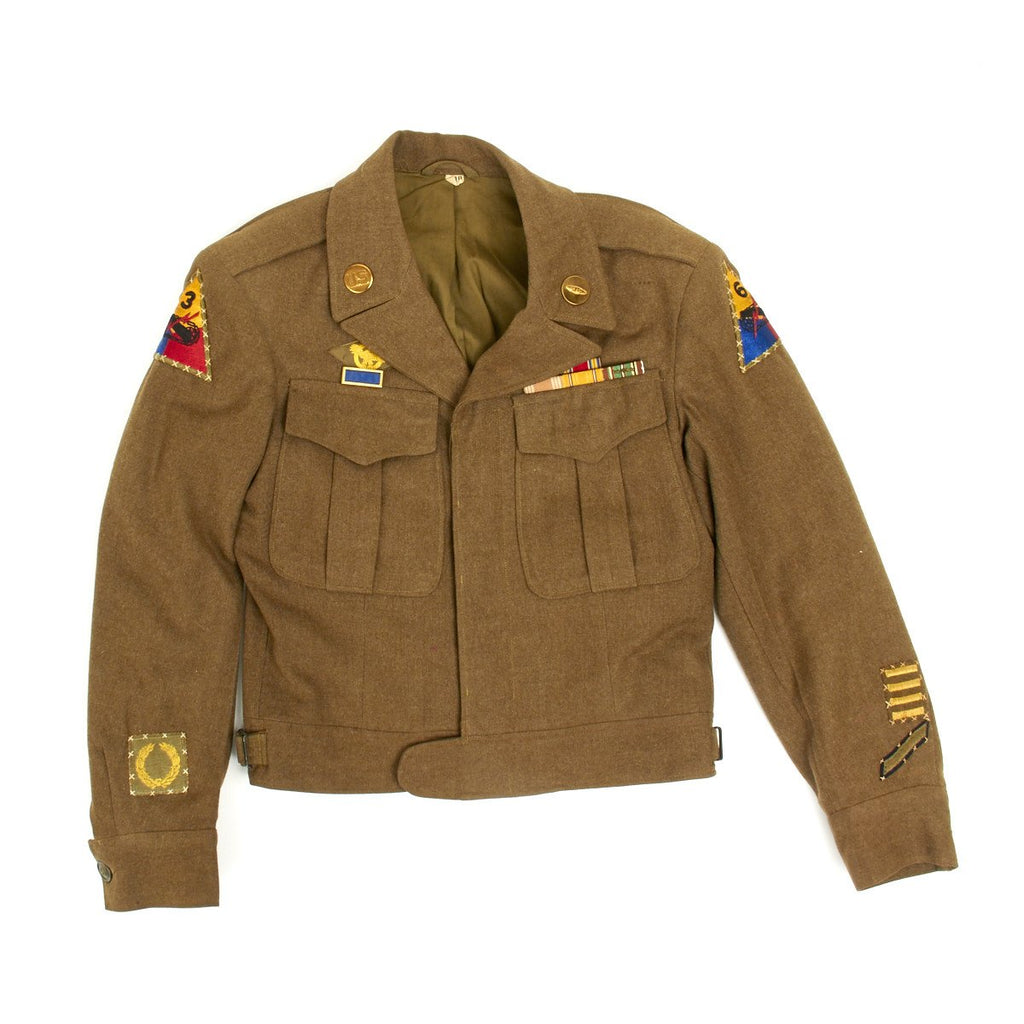-
Original Items: Only One Set Available. Included in this genuine WW2 grouping are the following:
Ike Jacket in excellent condition with correct 3rd Armored (right shoulder) and 6th Armored Division (right shoulder) patches, four overseas service sleeve stripes, service stripe, ruptured duck, WWII Presidential Unit Citation, medal ribbons as follows: WW2 Victory Medal, Army Good Conduct, American Defense Medal, European-Africa Middle Eastern Campaign with FIVE battle stars. The tunic is size 34 R. One of the best aspects of this jacket are the way the patches are stitched to the tunic: appealing small X shaped cross stitches.
Standard issue cotton khaki shirt.
Standard issue cotton khaki neck tie.
The 6th Armored Division "Super Sixth" was an armored division of the United States Army during World War II. It was formed with a cadre from the 2nd Armored Division. 6th AD was formed under the 1942 Table of Organization and Equipment.
The division was activated on 15 February 1942 at Fort Knox, with Brig. Gen. Carlos Brewer assigned as its first commanding general.[2] It moved to Camp Chaffee on 15 March 1942 to make way for other Armored units, and then completed its assembly and unit training. The division then participated in the VIII Corps Louisiana Maneuvers from 25 August 1942, and then returned to Camp Chaffee on 21 September 1942. The 6th AD then moved to Camp Young at the Desert Training Center on 10 October 1942, and participated in the first California Maneuvers. The 6th AD then moved to Camp Cooke to continue its training. The 6th AD then staged at Camp Shanks on 3 February 1944, departed the New York Port of Embarkation on 11 February 1944, and arrived in England on 23 February 1944.After continuing its training in England, 6th AD landed on Utah Beach in Normandy on 19 July 1944 as a follow-on unit, and went on the offensive as separate combat commands in the Cotentin Peninsula in support of the Normandy Campaign.
At the end of the Normandy Campaign, 6th AD assembled at Le Mesnil on 25 July 1944. 6th AD then passed through 8th Infantry Division to clear the heights near Le Bingard on 27 July 1944, and Combat Command A secured a bridgehead across the Sienne (fleuve) (fr) near Pont de la Roque on 29 July 1944, and overran Granville on 31 July 1944. 6th AD then returned to Avranches, where it relieved 4th AD and secured the area bridges.
Elements of the 6th AD also participated in the Pacific Theater seeing action in major engagements in that area of the war. The divisions were amphibious units, and thus used ranging variants of the LVT. The 69th Armor Regiment was composed, for the majority, of these amphibious divisions and was sent over to the Pacific. These units, such as the 773rd Amphibian Tractor Battalion, 776th Amphibian Tank Battalion, and 708th Amphibian Tank Battalion, saw action in the Mariana Islands (1944) at the battles of Saipan and Tinian, in the Marshall Islands (194344), the Ryukyu Islands (1945), and in the Philippine Islands as well as the Liberation of the Philippines. Some were also stationed in Japan during its occupation following the war's end.
In mid-August in Europe, the 6th Armored Division moved down to Lorient, where it was relieved by the 94th Infantry Division in September.
The 6th then turned east and cut across France, reaching the Saar in November. It crossed the Nied River on 1112 November, against strong opposition, reaching the German border on 6 December, and established and maintained defensive positions in the vicinity of Saarbrücken.
On 23 December, the division was ordered north of Metz to take part in the Battle of the Bulge, and took over a sector along the south bank of the Sauer. The 6th was heavily engaged in the battle for Bastogne, finally driving the enemy back across the Our River into Germany by late January 1945.
After a short period of rehabilitation, the division resumed the offensive, penetrated the Siegfried Line, crossed the Prum, reached the Rhine River at Worms on 21 March, and set up a counterreconnaissance screen along its west bank. The 6th crossed the Rhine at Oppenheim on 25 March, drove on to Frankfurt, crossed the Main, captured Bad Nauheim, and continued to advance eastward, and surrounded and captured Mühlhausen on 45 April. After repulsing a light counterattack, it moved forward 60 miles to cross the Saale River and assisted in freeing Allied prisoners of war and the German prison camp at Buchenwald. The division raced on, took Leipzig, crossed the Mulde River at Rochlitz on 15 April 1945, and stopped, pending the arrival of the Red Army. Defensive positions along the Mulde River were held until the end of hostilities in Europe.
The division was deactivated on 18 September 1945 at Camp Shanks, New York.
- This product is available for international shipping.
- Eligible for all payments - Visa, Mastercard, Discover, AMEX, Paypal & Sezzle


We Buy Military Antiques
Our team expert buyers travels the world to pay fair prices for entire estate collections to singular items.
START SELLING TODAY


























